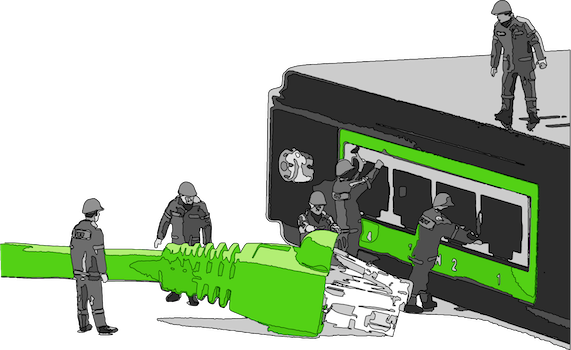New insight on wealth creation
 Sometimes a new book comes along that casts a refreshingly new perspective on an old problem. Such is the case with “Windows of Opportunity – How Nations Create Wealth” by David Sainsbury, which is not published in North America, but can be previewed and purchased on-line. Sainsbury has an interesting background — he was chairman of one of Britain’s largest supermarket chains and the country’s Minister of Science and Innovation for eight years. What is particularly interesting about his approach is that he brings not only practical ideas, but also places them in a theoretical context of economic thought and historical context.
Sometimes a new book comes along that casts a refreshingly new perspective on an old problem. Such is the case with “Windows of Opportunity – How Nations Create Wealth” by David Sainsbury, which is not published in North America, but can be previewed and purchased on-line. Sainsbury has an interesting background — he was chairman of one of Britain’s largest supermarket chains and the country’s Minister of Science and Innovation for eight years. What is particularly interesting about his approach is that he brings not only practical ideas, but also places them in a theoretical context of economic thought and historical context.
Two schools of thought
Sainsbury describes the two schools of thought that have tried to explain economic growth as the market efficiency school and the production capability school. These two schools of thought have been embraced at different points in time by different economists and policymakers.
The market efficiency school includes Adam Smith, Paul Samelson, and Paul Krugman. In this school, wealth originates from material sources: land, physical labour, and capital. It sees the market as a machine that, with the “invisible hand” of the market, functions as a self-organizing system. So there is no role for government in this school, and all economic activity has equal growth potential. It is the rationale for the laissez-faire approach to business.
The production capability school includes such figures as Alexander Hamilton, Joseph Schumpeter, and Friedrich List. This school assigns the origin of wealth to innovation and creativity, which grows with the accumulation of a stock of knowledge. Different types of economic activity therefore have different growth potential, establishing the rationale for industrial policy.
The dynamic capability theory of economic growth
Sainsbury’s theory is firmly in the production capability school. He sees the key question raised by economic growth theory as being how firms gain competitive advantage over their rivals. They can do this in two ways — by reducing the cost of their product or service through innovation, or using innovation to make their products more attractive to their customers. How well they do this is determined by the capabilities of firms, matched to the respective market opportunities they see. This relationship varies between different sectors of the economy. He distinguishes between two kinds of capability — maintaining the existing operation effectively (i.e. doing things right), and to identifying and pursuing new opportunities (i.e. doing the right things).
He sees that a nation’s standard of living over the long term depends on the ability of its firms to to attain a high and rising level of value added per capita in the industries in which they compete. To create a competitive advantage a firm needs to be able to identify “windows of opportunity” and have the organizational and technological capabilities to take advantage of it. A firm’s ability to sustain its competitive advantage over time will consequently depend on how quickly its competitors can imitate its strategy.
The theory is very sector specific and places great emphasis on value-added per capita. This metric correlates closely with quality of life, while growth by itself is not a useful metric. For example, if the economy grows at 3 percent and the population grows by 4 percent, the value added per capita decreases, and the country gets poorer. The growth opportunities and value added per capita are distributed very unequally between sectors. If we look at Canada, the value-added per hour for selected sectors for 2022 is shown in the table below.
Industry sector
Value-added per hour ($) 2022
Natural gas pipelines
587
Potash Mining
567
Finance and Insurance
90
ICT sector
82
Software publishers
81
All manufacturing
63
ALL INDUSTRIES
61.1
Motor vehicle manufacture
59
Legal services
58
All services
50
Retail trade
35
Food and beverage stores
26
Taxi and limousine service
17
Source: Statistics Canada Table 36-10-0480-01
It is clear the highest value added sectors are very capital-intensive, with few workers. Sainsbury explains that if a person moves from working in a low value-added sector to a high value-added sector, the value added per capita for the country improves. So, if a proverbial immigrant PhD taxi driver (value-added $17/hour) in Canada gets a job with an ICT company (value-added $82/hour), Canada’s value-added per capita increases.
He also makes the point that while around 80 percent of the economy is domestic (hairdressers, retail stores, etc.), it is the internationally traded sectors that determine the country’s competitiveness.
Firm capabilities
The dynamic capability theory places a firm’s development capabilities at the centre of its approach. This is essentially an entrepreneurial activity carried out within the firm (i.e. otherwise called intrapreneurship.) It has three parts: first, the identification and assessment of opportunities; second, the development of new technological and organizational capabilities to pursue the opportunity; and third, continuous renewal and transformation of the firm. Sainsbury points out that developing these capabilities in a firm is a long-term undertaking, at odds with the culture of producing short-term financial gains. He argues firms should rebalance the incentives for executives, placing more emphasis on developing organizational capabilities, rather than seeking short-term financial results.
Government’s role
Government needs to have a vision of what it wants to achieve, and the capability to develop and implement the policies necessary to put it into practice. Sainsbury recounted his experience in the British government, where this was not the case. He strongly recommends that governments give priority to developing capabilities and experience and institutional memory in government and to have consistent policies and avoid what he called “policy churn”. This includes a capability to evaluate previous policies and learn from them and to learn from the experiences of other countries facing similar issues.
Conclusion
The growth of high value-added per capita industries is the key to economic development, and the creation of competitive advantage by innovation is the way to get there.
The key capability a firm needs to create competitive advantage is an entrepreneurial developmental competence.
Firms should incentivize their executives to build up technological and organizational capabilities to pursue new opportunities and decrease the emphasis on short term financial results.
Governments should build an effective system of policymaking. This includes the capacity to evaluate past policies, learn from the experiences of other countries facing similar issues, and create an organizational memory.
Peter Josty is Executive Director of The Centre for Innovation Studies (THECIS), a Calgary-based not-for-profit research company specializing in innovation and entrepreneurship. In addition to working in private research and business development, he holds a PhD in chemistry from the University of London and an MBA from the International Institute for Management Development in Geneva.
R$
| Organizations: | |
| People: | |
| Topics: |
Events For Leaders in
Science, Tech, Innovation, and Policy
Discuss and learn from those in the know at our virtual and in-person events.
See Upcoming Events
You have 0 free articles remaining.
Don't miss out - start your free trial today.
Start your FREE trial Already a member? Log in
By using this website, you agree to our use of cookies. We use cookies to provide you with a great experience and to help our website run effectively in accordance with our Privacy Policy and Terms of Service.





